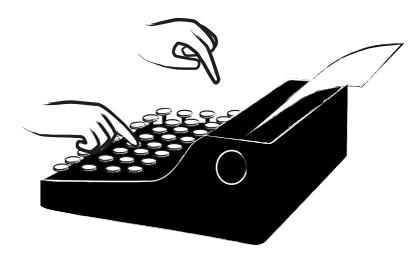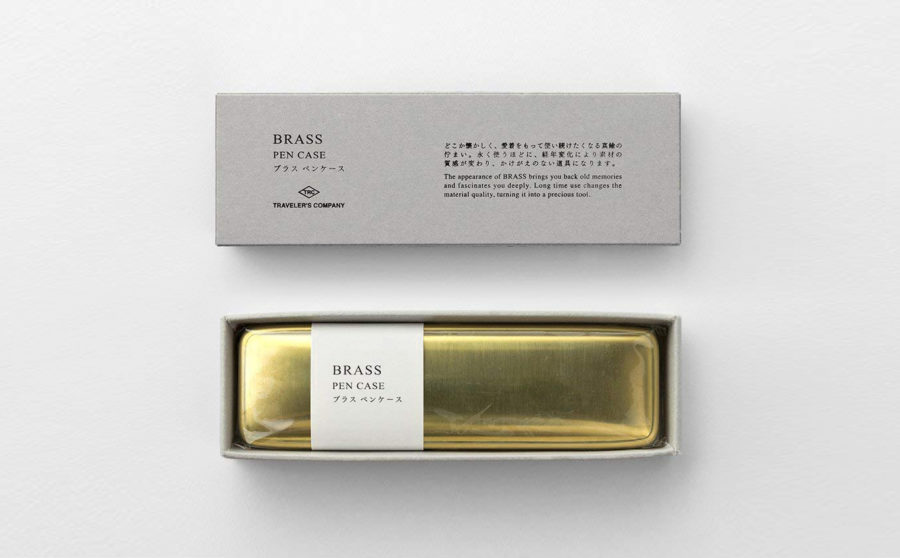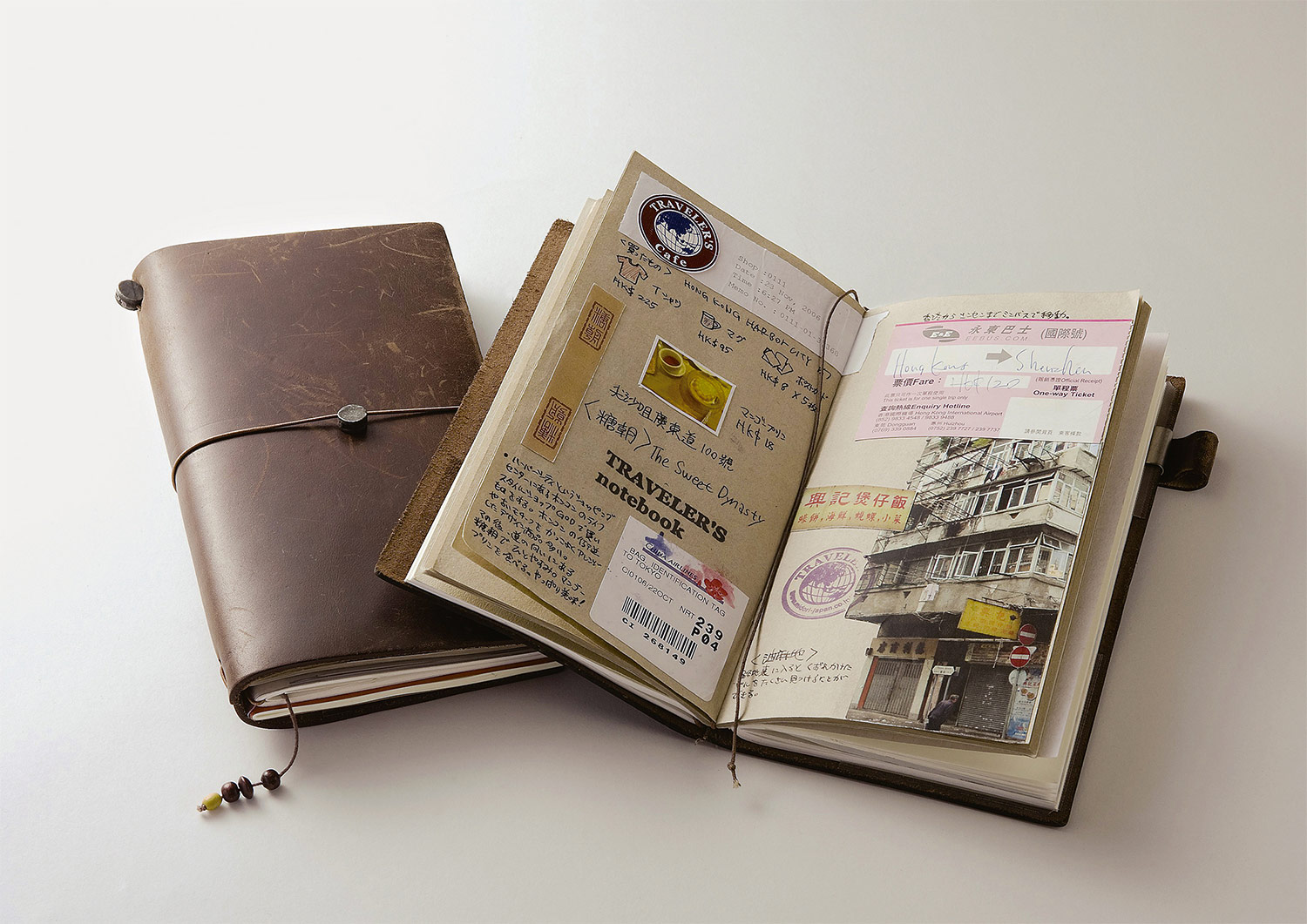Le Traveler’s Notebook
A contre-courant des produits de consommation modernes qui conditionnent nos besoins et qu’on remplace une fois cassés ou dépassés, la société japonaise TRAVELER’S COMPANY – anciennement Midori – a imaginé un carnet de notes de fabrication artisanale qui confère à son propriétaire une sensation de liberté par sa simplicité et sa solidité. En outre, ce carnet fait redécouvrir l’expérience à la fois stimulante et créative de l’écriture à la main, aujourd’hui presque disparue.
Créé en 2006, le carnet se compose d’un cahier interchangeable enveloppé d’une couverture en cuir souple dont l’aspect se bonifie avec le temps et l’usage. Le minimalisme formel du carnet permet à son propriétaire de le personnaliser presqu’à volonté en fonction de ses besoins et de ses goûts : différents types de cahiers et accessoires sont prévus pour accompagner le carnet.
En complément de la papeterie, TRAVELER’S Company a développé en 2010 une gamme de stylos en cuivre brut dont la forme, le matériau et le poids le rapproche davantage de l’outil artisanal que du simple crayon.
En. A modern technology becomes more and more essential in our daily life, writing by hand seems more and more old-fashioned. Using our hands to write or draw has become an unusual experience. In 2006 in the wake of this high-tech age, Traveler’s Company started making artisanal notebooks to keep the writing experience special. Made of solid materials – leather and brass – their designs are very simple. But the objects create a presence on our desks and in our hands and in our bags with their evolving textures.
‘When thinking of the materials, the form, the mechanism of the pen, we don’t just imagine the pen’s performance. We consider the weight and feel on your hand, your natural movements when you using it, the appearance when you set it down and how it would evolve as you use it more and more.’
Traveler’s Company has continued to design their stationary focusing on raw materials like brass and leather in which we can feel accumulated time. They changed their name Midori to Traveler’s Company to emphasize the idea of traveling with their notebooks.

![]()
01. Comment avez-vous commencé TRAVELER’S COMPANY?
Nous avons lancé TRAVELER’S notebook en 2006 sous la marque MIDORI après avoir remporté le deuxième prix lors d’un concours de design. Nous présentions un carnet de format A5 en cuir brut. A cette époque, ce genre de design n’existait pas. C’est ce qui nous a motivé à développer ce produit.
La couverture est fabriquée à la main dans une petite usine à Chiang Mai en Thaïlande. Le cuir est un matériau noble mais qui est difficile à utiliser s’il n’est pas traité. Il était important de réfléchir à une harmonie entre l’usage et la caractéristique du matériau. C’est pourquoi nous l’avons associé avec un carnet de papier blanc japonais.
Plus tard, nous avons eu l’idée d’intégrer différents modèles de papiers. Aujourd’hui, nous en avons plusieurs que nous pouvons choisir selon les besoins. Ensuite, nous avons créé un porte crayon qui s’intègre au carnet.
Il était important de créer un produit simple afin qu’il soit facilement personnalisable et qu’il puisse refléter la personnalité des gens. C’est ça l’important. Plus il est personnalisable, plus on l’apprécie et il devient précieux. Un jour, lors d’un voyage, j’ai accidentellement laissé une trace de café sur mon carnet. Une fois rentré au Japon, en revoyant cette trace, des souvenirs de ce moment me sont revenus.
Après la sortie du TRAVELER’S NOTEBOOK, nous avons élargi notre gamme de produits avec des accessoires en cuivre et des carnets à spirales. Nous avons ouvert le magasin TRAVELER’S FACTORY à Tokyo. Tous nos produits partagent le thème du voyage dans la vie quotidienne. Afin de poursuivre et d’enrichir ce thème, nous avons changé la marque de MIDORI en TRAVELER’S COMPANY en 2015.
How did you start TRAVELER’S COMPANY?
We launched TRAVELER’S notebook in 2006 —our first product as MIDORI brand— after a design competition where we installed a stand to present our notebook design and we won the second prize. We made A5 size notebooks with rough cutting leather cover which was not so popular at the time. After that we wanted to develop our notebook design.
The leather cover is handmade in a small factory in Chiang Mai, Thailand. The leather is a beautiful material but it is not easy to use if it is not treated at all. It looks and feels much too primitive. It was important to find a good balance between its usage and the characteristics of the material. The very first idea was to make a notebook cover. After that competition, our team started to use the notebook in our own life. And we got the idea to place several notebooks inside. Then we wanted to add a pen holder. That’s why we made a pen holder which works well with our notebook. One day a client proposed to us to use more different types of paper, like for drawing. Now we make many different types of paper, so we can select the paper that we like to put inside.
However it was very important to make something ‘simple’ to store each person’s memories with a design that is easy to personalize. We think it is important to allow the personalization of our notebooks to show our customer’s personality through them. For example, my handwriting is a little messy but I think it reveals my personality. The more it is personalized, the more I like it. And I become closer with myself using my own notebook. Sometimes I leave a coffee trace during my travels and when I see it later I recall that moment.
After releasing TRAVELER’S notebook, we expanded our products line-up as like BRASS PRODUCTS and SPIRAL RING NOTEBOOK, and opened the flag ship store called TRAVELER’S FACTORY in Tokyo. All these products share the theme of traveling that takes place in one’s daily life. In order to pursue and enrich this theme, we changed the brand name from MIDORI to TRAVELER’S COMPANY in 2015.

02. Quelles textures aimez-vous ?
Nous aimons le laiton et le cuire car ce sont des matériaux qui changent avec le temps. Ils embellissent et prennent de la valeur en vieillissant contrairement aux produits modernes comme les téléphones par exemple.
03. Quelles difficultés avez-vous rencontré en développant vos produits en cuivre ?
Nous avons investis beaucoup de temps. Le plus difficile a été de trouver une usine qui fabrique des produits en cuivre. Nous voulions travailler avec des artisans japonais, mais la plupart ferment leur atelier pour s’installer en Chine.
Avant tout, nous utilisons du cuivre non traité car il change facilement de couleur. Beaucoup d’usines refusaient de fabriquer nos produits parce qu’elles considéraient comme un défaut le fait que le matériau change avec le temps. Ils préféraient faire des produits vernis pour conserver une texture brillante. C’était donc difficile de les convaincre de fabriquer des produits non traités.
What kind of textures do you like?
We like brass and leather because these materials change with time. They become more charming. It is different with a smartphone, for example, which loses its value with time. But these kinds of materials—leather and brass—they become even more precious because we can feel the time that has passed.
Which difficulties did you have in developing your brass products?
For our brass products, we invested more time to develop them. To accomplish our design, we needed to find a factory which could fabricate brass products. And in Japan many factories had closed and moved to China. So that was the first thing to do, to find a factory that could work with us because we wanted to keep working with Japanese craftsman.
Above all else we use untreated brass. And it could change its color. Many factories didn’t want to fabricate our design because they considered it like a fault – to change its color. Simply touching it could change the material. They preferred to make products with a coating to keep a shiny texture. So it was difficult to convince the craftsman to make uncoated brass products.
[column column= »one-half »] 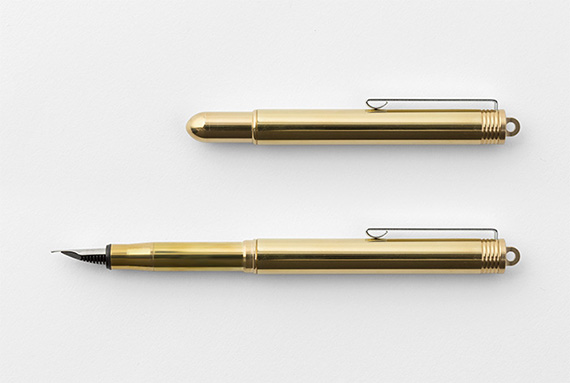 [/column][column column= »one-half »]
[/column][column column= »one-half »] 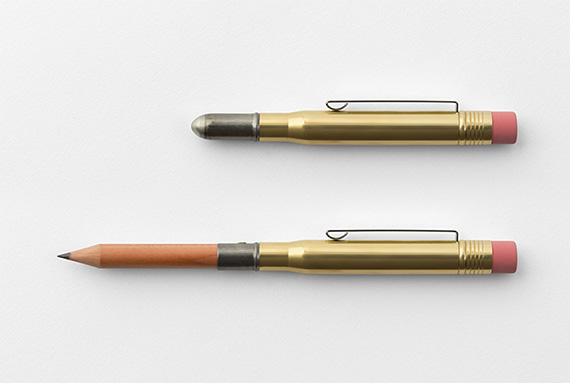 [/column]
[/column]
[column column= »one-half »] 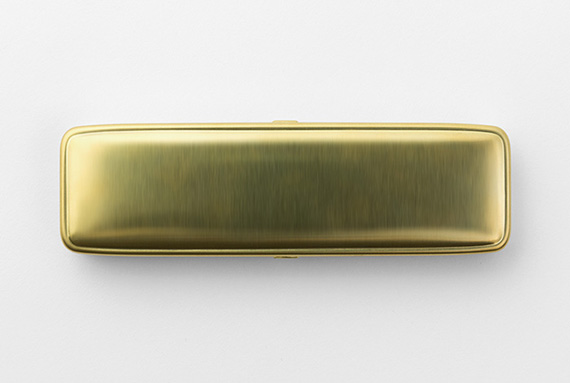 [/column][column column= »one-half »]
[/column][column column= »one-half »] 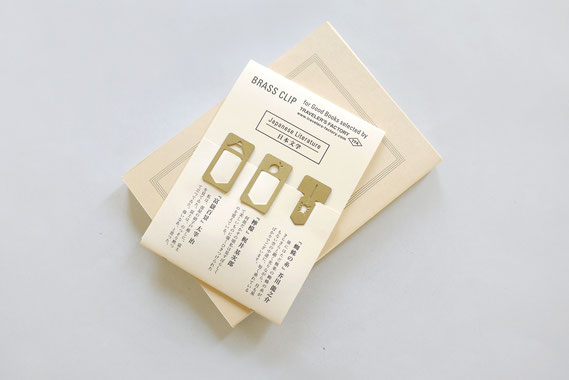 [/column]
[/column]
04. Quel regard portez-vous sur les produits digitaux qui ont remplacé le papier et le crayon ?
Ecrire à la main est une démarche différente qu’écrire avec un clavier. Pour simplement noter des informations, je trouve suffisant d’utiliser des produits digitaux, mais pour exprimer des sentiments, des souvenirs – nous préférons écrire à la main.
05. Êtes-vous influencés par la culture japonaise ?
Nous sommes japonais, donc même sans réfléchir, ça vient naturellement. Par exemple notre packaging vient de la manière traditionnelle japonaise d’envelopper l’argent dans un tissus en papier lors de cérémonies importantes. De plus, nous aimons la simplicité. Nous pouvons trouver cette simplicité dans le design japonais traditionnel.
replacing paper and writing materials?
The desire to write with our hands – I think it is different than writing in the digital realm. Simply for noting some brief information, it could be enough. However to express and to trace our emotions, we prefer to write by hand.
We are Japanese. Even if we don’t reflect on it, it comes naturally. We like the simplicity and we can find this simplicity in traditional Japanese design. The packaging design comes, for example, from the traditional Japanese way of wrapping money in tissue paper for important ceremonies.
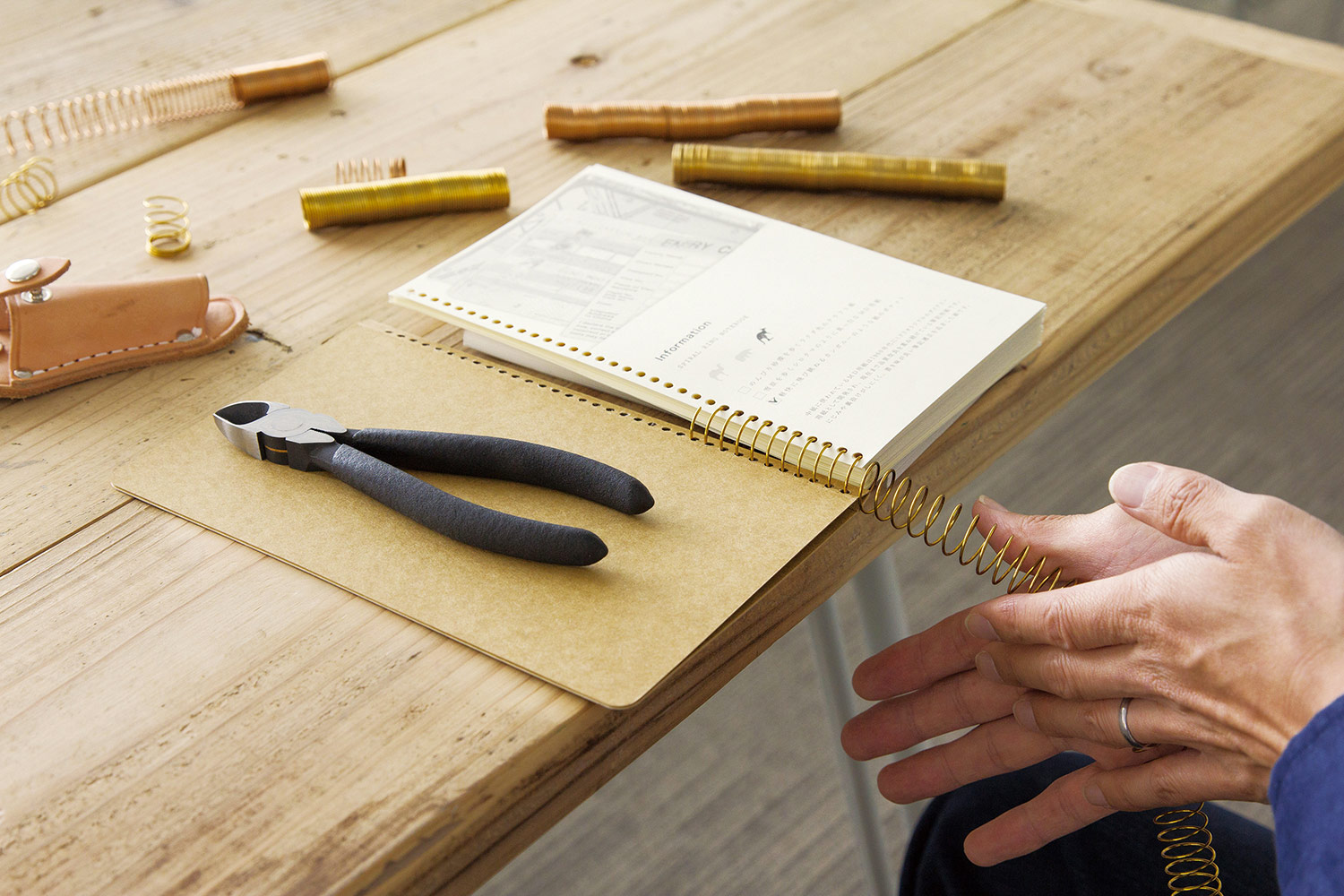
[column column= »one-half »]
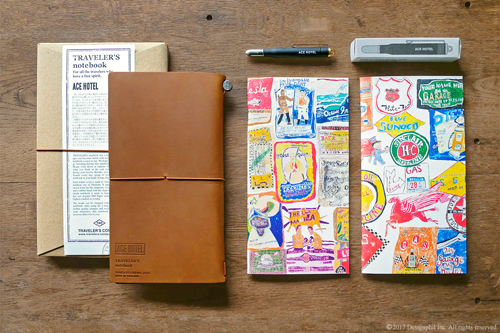
[/column][column column= »one-half »]
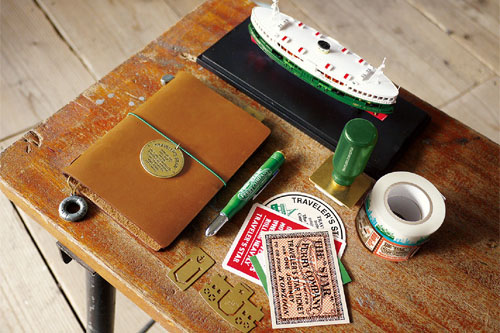
[/column]
06. Vous faites beaucoup de collaborations, pouvez vous nous en parler ?
Nous adorons les collaborations, à chaque fois c’est une expérience enrichissante pour nous. Parfois les gens nous contactent, d’autres fois, c’est nous qui les contactons. Pour un restaurant situé à Hawaï, nous avons développé un design de carnet en utilisant leur menu.
Nous avons également collaboré avec la société Hongkongaise Star Ferry. Les carnets issus de cette collaboration sont vendus avec un ticket de ferry utilisable. Pour les clients, c’est une nouvelle expérience. Pour notre collaboration avec Ace Hotels, nous avons organisé un événement durant lequel les gens pouvaient fabriquer leur propre SPIRAL RING NOTEBOOK en combinant différents types de papier. A la fin, un artisan les reliait à la main avec une reliure à spirales métalliques.
How did you start the different collaborations?
We enjoy collaborating, it is a new experience for us. Sometimes people contact us and sometimes we contact them. For example, we collaborated with a restaurant in Hawaii and used their menu to develop our design.
We also collaborated with a Hong Kong Star Ferry. When you buy a notebook from this ferry collection, it comes with a ticket that you can use to go on the ferry. Customers also can just buy a normal ticket but this makes it a whole new experience. And some people enjoy it. For our collaboration with Ace Hotels, we organized an event where people combined different types of paper to make their own SPIRAL RING NOTEBOOK. And when they finished selecting their paper, our craftsman put in the spiral by hand.

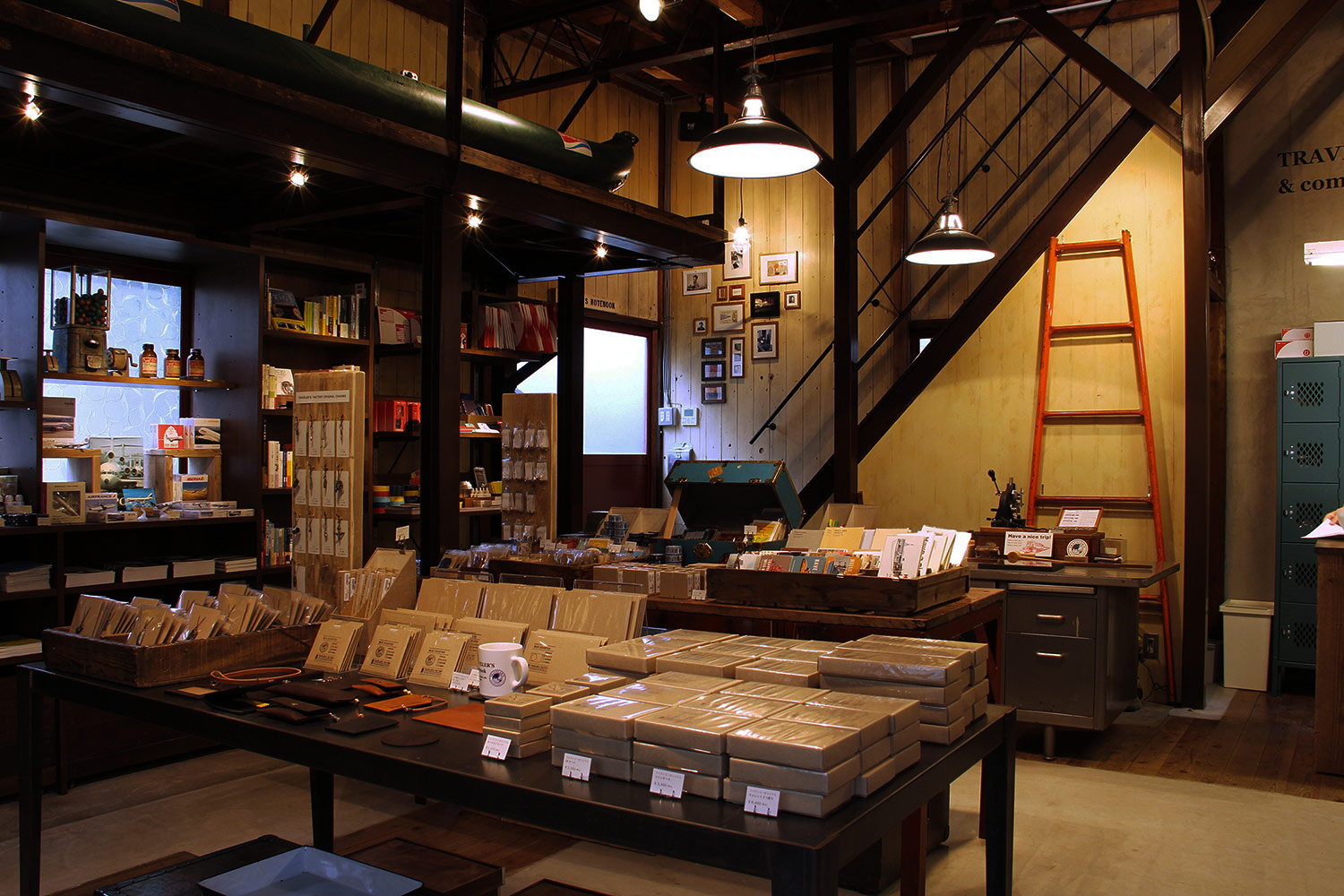 TRAVELER’S FACTORY as the flagship store opened in Nakameguro, Tokyo in 2011
TRAVELER’S FACTORY as the flagship store opened in Nakameguro, Tokyo in 2011
TRAVELER’S COMPANY
http://www.travelers-company.com/
About TRAVELER’S notebook
http://www.travelers-company.com/products/trnote/about
